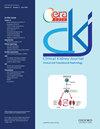Urinary soluble PD-1 as a biomarker of Checkpoint Inhibitor induced acute tubulointerstitial nephritis
IF 4.6
2区 医学
Q1 UROLOGY & NEPHROLOGY
引用次数: 0
Abstract
Background Acute interstitial nephritis (AIN) related to Immune Checkpoint Inhibitors (ICI-AIN) has a not completely understood pathophysiology. Our objectives were to analyze possible biomarkers for the differentiation between acute tubular necrosis (ATN) and AIN, especially in cancer patients, and to study the participation of the immune checkpoint pathway in ICI-AIN. Methods We performed an observational study. We recruited patients with incident diagnosis of ICI-AIN (n=19). We measured soluble PD-1 (sPD-1), sPD-L1 and sPD-L2 in serum and urine at diagnosis and compared to patients with non ICI-related AIN (non-ICI AIN) (n=18) and ATN (n=21). The findings were validated in an independent cohort from another institution (n=30). Besides, we performed PD-L1 and PD-L2 immunostaining of kidney biopsies from patients with ICI-AIN and compared to patients with non-ICI AIN. Results Urinary sPD-1 (usPD-1) was higher in patients with AIN compared to ATN (p=0.03). Patients with AIN also showed higher serum sPD-1 (ssPD-1) than patients with ATN (p=0.021). In cancer patients, usPD-1 <129.3 pg/ml had a 71.43% sensitivity and 94.44% specificity to differentiate ATN from ICI-AIN, with a likelihood ratio of 12.86. In the external validation cohort, the same cutoff showed a sensitivity of 80%. In kidney biopsies, patients with ICI-AIN showed higher density of PD-L1 positive tubules than patients with non-ICI AIN (p=0.02). The proportion of patients having more than 2.64/mm2 PD-L2 positive tubules was higher among patients with ICI-AIN compared to non-ICI AIN (p=0.034). There was a positive correlation (p=0.009, r=0.72) between usPD-1 and the number of PD-L1 positive tubules. Conclusions UsPD-1 and ssPD-1 are higher in AIN than ATN. Moreover, there was a strong correlation between usPD-1 and renal tubular PD-L1 expression. Our findings suggest a role of usPD-1 as non-invasive biomarker to differentiate ICI-AIN from ATN, especially in cancer patients, which has been confirmed in an external validation cohort.尿液可溶性 PD-1 作为检查点抑制剂诱发急性肾小管间质性肾炎的生物标记物
背景与免疫检查点抑制剂有关的急性间质性肾炎(AIN)的病理生理学尚未完全清楚。我们的目标是分析区分急性肾小管坏死(ATN)和 AIN 的可能生物标志物,尤其是在癌症患者中,并研究免疫检查点通路在 ICI-AIN 中的参与情况。方法 我们进行了一项观察性研究。我们招募了偶发诊断为 ICI-AIN 的患者(19 人)。我们测量了诊断时血清和尿液中的可溶性 PD-1(sPD-1)、sPD-L1 和 sPD-L2,并与非 ICI 相关 AIN(non-ICI AIN)患者(18 人)和 ATN 患者(21 人)进行了比较。这些结果在另一机构的独立队列(30 人)中得到了验证。此外,我们还对 ICI-AIN 患者的肾活检组织进行了 PD-L1 和 PD-L2 免疫染色,并与非 ICI AIN 患者进行了比较。结果 AIN 患者尿液中的 sPD-1(usPD-1)高于 ATN 患者(P=0.03)。AIN 患者的血清 sPD-1 (ssPD-1) 也高于 ATN 患者(P=0.021)。在癌症患者中,usPD-1 <129.3 pg/ml 对区分 ATN 和 ICI-AIN 的敏感性为 71.43%,特异性为 94.44%,似然比为 12.86。在外部验证队列中,同一临界值的灵敏度为 80%。在肾活检中,ICI-AIN 患者的 PD-L1 阳性肾小管密度高于非 ICI AIN 患者(P=0.02)。与非 ICI AIN 患者相比,ICI-AIN 患者中 PD-L2 阳性小管超过 2.64 个/mm2 的比例更高(p=0.034)。usPD-1 与 PD-L1 阳性小管的数量呈正相关(p=0.009,r=0.72)。结论 AIN 中的 UsPD-1 和 ssPD-1 高于 ATN。此外,usPD-1与肾小管PD-L1表达之间存在很强的相关性。我们的研究结果表明,usPD-1 是区分 ICI-AIN 和 ATN(尤其是癌症患者)的非侵入性生物标志物,这一点已在外部验证队列中得到证实。
本文章由计算机程序翻译,如有差异,请以英文原文为准。
求助全文
约1分钟内获得全文
求助全文
来源期刊

Clinical Kidney Journal
Medicine-Transplantation
CiteScore
6.70
自引率
10.90%
发文量
242
审稿时长
8 weeks
期刊介绍:
About the Journal
Clinical Kidney Journal: Clinical and Translational Nephrology (ckj), an official journal of the ERA-EDTA (European Renal Association-European Dialysis and Transplant Association), is a fully open access, online only journal publishing bimonthly. The journal is an essential educational and training resource integrating clinical, translational and educational research into clinical practice. ckj aims to contribute to a translational research culture among nephrologists and kidney pathologists that helps close the gap between basic researchers and practicing clinicians and promote sorely needed innovation in the Nephrology field. All research articles in this journal have undergone peer review.
 求助内容:
求助内容: 应助结果提醒方式:
应助结果提醒方式:


